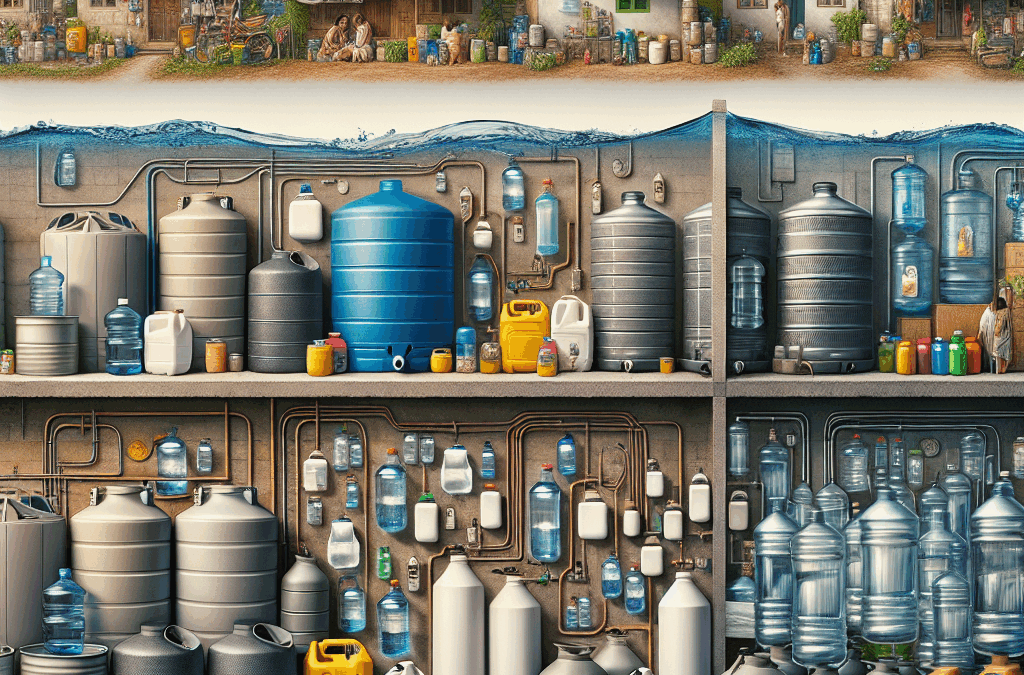Assessing Your Water Needs
Understanding Daily Consumption
To kick things off, the first thing you gotta do is genuinely understand how much water you and your family consume daily. This ain’t just about drinking; think cooking, cleaning, and hygiene too. Honestly, you’ll be surprised how quickly those gallons add up when you really start thinking about it!
Start by tracking your usage over a week or so. Grab a notebook or even your phone, and jot down how much water you use for everything. Are you filling the kettle for tea? That’s part of it! Washing the dishes? Don’t overlook that. It all counts!
Once you have a clear picture of your family’s needs, you can assess how much water you’d want to store for emergencies. Trust me, having that knowledge is like having a roadmap—it guides your decisions for how much water you really need to store away.
Choosing the Right Storage Containers
Types of Containers
Now that you’ve got an idea of how much water you need, it’s time to talk about containers. You can’t just fill up your old soda bottles and call it a day, folks! There are proper water storage containers designed specifically for this purpose.
You can go for food-grade plastic containers, which are lightweight and durable. There are also glass containers that, while a bit heavier, don’t leach chemicals over time. Then you’ve got stainless steel, which is awesome for keeping things fresh but can be a little pricey. Consider your space and budget before diving in!
Always remember to check for any leaks or cracks before using them. You wouldn’t want to be caught with a busted container when it’s crunch time. It’s all about being proactive instead of reactive when it comes to water storage!
Thank you for reading this post, don't forget to subscribe NOW for FREE!
Treating the Water Before Storage
Using Water Purification Methods
So, let’s chat about treating the water before you pop it in the container. Gender aside, I know we all assume water straight from the tap is good to go. But, if you’re storing it long-term, you might wanna jump through a few hoops to treat it properly.
One popular method is using water purifying tablets or drops, which can eliminate bacteria and viruses that might mess with your health. You can also boil the water for a minute or two, depending on where you live. Just remember to let it cool before pouring it into your containers!
Ultimately, treating your water ensures you’re not just hoarding plain old H2O, but really good, clean water that’ll keep your family safe in an emergency. Believe me, it’s worth the extra step!
Proper Storage Practices
Finding a Suitable Location
Alright, let’s get into the nitty-gritty of storage. It’s super important to pick a good spot for your water containers. Ideally, you want them kept in a cool, dark area away from direct sunlight, which can degrade the plastic over time.
If you’re like me, you might think the garage or basement is the perfect spot, but make sure it’s dry and out of reach from potential leaks or flooding. If the containers are in an old shed, check for critters creeping around. Those little guys could make a mess of your supplies!
And, don’t just shove those containers in a corner and forget about them. Rotate your water supply every six months or so, and do a visual check every now and then. It’s a simple task that can save you major headaches later.
Regular Maintenance and Safety Checks
Updating Your Supply
Your long-term water storage isn’t a “set it and forget it” deal. Just like my favorite plants, it needs some maintenance to make sure it’s good to go! This means regularly checking your supply and updating it when necessary.
As mentioned earlier, every six months is a good rule of thumb for rotating out older water supplies, but also keep tabs on the containers. Inspect them for leaks, discoloration, or any signs of wear and tear. If something looks off, it’s best to replace it.
And don’t forget to keep an eye on the overall condition of your storage area too. Keep it tidy and organized; a cluttered storage space can lead to accidents or even mix-ups with different liquids. Practicing regular maintenance feels a little tedious, but trust me, it’ll pay off big time when you’re in a pinch!
Frequently Asked Questions
1. How long can water be stored for?
With proper storage techniques, you can safely store water for 6 months to a year. Just remember to check it periodically!
2. Can I store water in my bathtub?
Yes, in emergency situations, you can fill your bathtub with water. However, make sure it’s clean and consider treating it with purification tablets if you’re going to use it later.
3. Is there a specific way to seal my water containers?
You want to ensure your containers are tightly sealed and that any caps or lids are snug. You can even use tape around the edges for an extra seal if you’re worried.
4. Do I need to treat tap water before storing it?
While tap water is generally safe, treating it with purification methods can help eliminate any pathogens, particularly if it’s going to be stored long-term.
5. How do I know if my stored water is safe to drink?
Before consuming stored water, conduct a visual inspection for any contaminants or odd smells. If everything looks good, you can taste a small amount; trust your instincts, and if anything seems off, don’t drink it.






